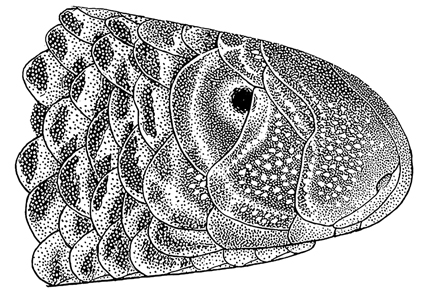Abstract
Melanesian blindsnakes of the genus Gerrhopilus have been little collected or researched. I examined specimens assigned in museums to Gerrhopilus inornatus and found considerable morphological diversity among them that indicates the presence of multiple species. I redescribe G. inornatus (Boulenger) based on the holotype and one additional specimen, and I describe six new species among specimens currently subsumed under that name from Papua New Guinea: Gerrhopilus flavinotatus sp. nov., Gerrhopilus lorealis sp. nov., Gerrhopilus papuanorum sp. nov., Gerrhopilus polyadenus sp. nov., Gerrhopilus slapcinskyi sp. nov., and Gerrhopilus wallachi sp. nov. Each species is currently known from only 1–3 specimens, and all but two are known only from single localities. In addition to traditional information on scale counts, habitus, and color patterns, I found the numbers and distributions of epidermal glands among the head shields to be especially useful for discriminating among species. The number of recognized Melanesian Gerrhopilus has increased tremendously in recent years, but the region has been poorly sampled for these snakes, and it is to be expected that additional species will be identified at such time as surveys can more effectively target these cryptic snakes.
References
Administrator, British New Guinea. (1902) Annual Report on British New Guinea from 1st July, 1900, to 30th June, 1901; with appendices. Government of the Commonwealth of Australia, Brisbane, xxx + 134 pp.
Boulenger, G.A. (1888) Descriptions of new reptiles and batrachians obtained by Mr. H.O. Forbes in New Guinea. Annals and Magazine of Natural History, Series 6, 1 (5), 343–346. https://doi.org/10.1080/00222938809460739
Brongersma, L.D. (1934) Contributions to Indo-Australian herpetology. Zoologische Mededelingen, 17, 161–251.
de Rooij, N. (1917) The reptiles of the Indo-Australian Archipelago, II: Ophidia. E.J. Brill, Leiden, 334 pp.
Forbes, H.O. (1888) On attempts to reach the Owen Stanley Peak. The Scottish Geographical Magazine, 4, 401–415. https://doi.org/10.1080/14702548808554987
Jan, G. (1860) Iconographie générale des ophidiens. 1. Livraison. J.B. Bailière et Fils, Paris. [unknown pagination]
Kraus, F. (2005) New species of blindsnake from Rossel Island, Papua New Guinea. Journal of Herpetology, 39, 591–595. https://doi.org/10.1670/86-05A.1
Kraus, F. (2017) New species of blind snakes (Squamata: Gerrhopilidae) from the offshore islands of Papua New Guinea. Zootaxa, 4299 (1), 75–94. https://doi.org/10.11646/zootaxa.4299.1.3
McDowell, S.B. (1974) A catalogue of the snakes of New Guinea and the Solomons, with special reference to those in the Bernice P. Bishop Museum. Part I. Scolecophidia. Journal of Herpetology, 8, 1–57. https://doi.org/10.2307/1563076
Pigram, C.J. & Davies, H.L. (1987) Terranes and the accretion history of the New Guinea Orogen. BMR Journal of Australian Geology and Geophysics, 10, 193–211.
Pigram, C.J. & Symonds, P.A. (1991) A review of the timing of the major tectonic events in the New Guinea Orogen. Journal of Southeast Asian Earth Sciences, 6, 307–318. https://doi.org/10.1016/0743-9547(91)90076-A
Pyron, R.A. & Wallach, V. (2014) Systematics of the blind snakes (Serpentes: Scolecophidia: Typhlopoidea) based on molecular and morphological evidence. Zootaxa, 3829 (1), 1–81. https://doi.org/10.11646/zootaxa.3829.1.1
Savage, J.M. (1950) Two new blind snakes (genus Typhlops) from the Philippine Islands. Proceedings of the California Zoological Club, Palo Alto, 1, 49–54.
Shea, G.M. & Wallach, V. (2000b) New records and data for typhlopid snakes from Papua New Guinea. Science in New Guinea, 25, 67–69.
Sidharthan, C. & Karanth, K.P. (2021) India’s biogeographic history through the eyes of blindsnakes—filling the gaps in the global typhlopoid phylogeny. Molecular Phylogenetics and Evolution, 157, 107064. https://doi.org/10.1016/j.ympev.2020.107064
Sternfeld, R. (1913) Beiträge zur Schlangenfauna Neuguineas und der benachbarten Inselgruppen. Sitzungsberichte der Gesellschaft Naturforschender Freunde zu Berlin, 1913, 384–389.
Taylor, B., Goodliffe, A.M. & Martinez, F. (1999) How continents break up: Insights from Papua New Guinea. Journal of Geophysical Research, 104, 7497–7512. https://doi.org/10.1029/1998JB900115.
Vidal, N., Marin, J., Morini, M., Donnellan, S., Branch, W.R., Thomas, R., Vences, M., Wynn, A., Cruaud, C. & Hedges, S.B. (2010) Blindsnake evolutionary tree reveals long history on Gondwana. Biology Letters, 6, 558–561. https://doi.org/10.1098/rsbl.2010.0220
Wallach, V. (1993) The supralabial imbrication pattern of the Typhlopoidea (Reptilia: Serpentes). Journal of Herpetology, 27, 214–218. https://doi.org/10.2307/1564940
Wallach, V. (1995) A new genus for the Ramphotyphlops subocularis species group (Serpentes: Typhlopidae), with description of a new species. Asiatic Herpetological Research, 6, 132–150. https://doi.org/10.5962/bhl.part.7989
Wallach, V. (1996) Two new blind snakes of the Typhlops ater species group from Papua New Guinea (Serpentes: Typhlopidae). Russian Journal of Herpetology, 3, 107–118.
Wichmann, A. (1912) Résultats de l’expedition scientifique Néerlandaise la Nouvelle-Guinée en 1903 sous les auspices de Arthur Wichmann, vol. II, 2ème partie, Entdeckungsgeschichte von Neu-Guinea (1885 bis 1902). Nova Guinea, 2, 371–1026.
Wynn, A. (2021) A new species of Gerrhopilus (family: Gerrhopilidae), with comments on the taxonomic status of Gerrhopilus ater suturalis (Brongersma). Anatomical Record, 304, 2243–2248. https://doi.org/10.1002/ar.24726
Zweifel, R.G. (1979) Variation in the scincid lizard Lipinia noctua and notes on other Lipinia from the New Guinea region. American Museum Novitates, 2676, 1–21. http://hdl.handle.net/2246/5434


